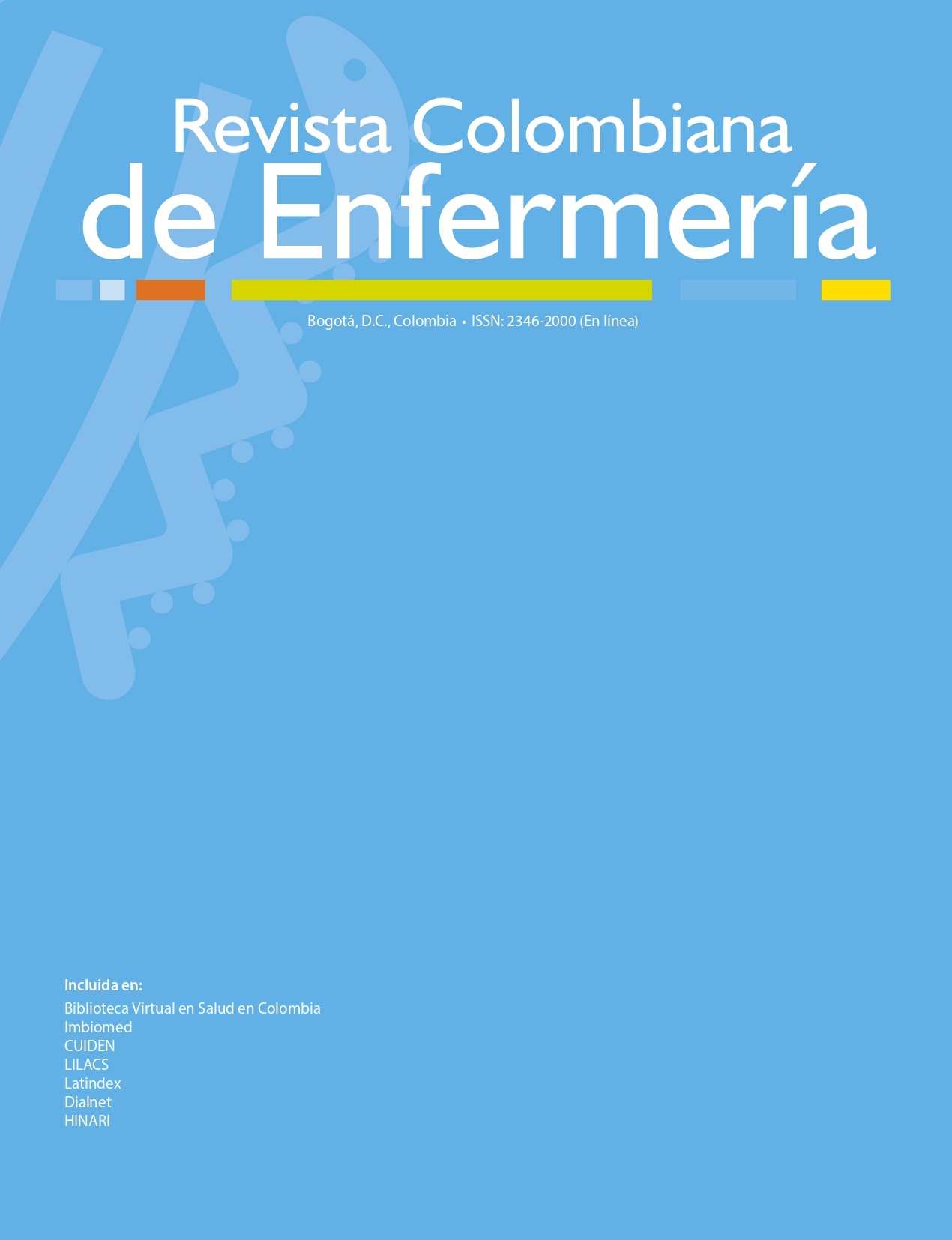Uso de adhesivos médicos y lesiones de piel
prevalencia en Colombia
DOI:
https://doi.org/10.18270/rce.v18i3.2608Palabras clave:
Epidemiología, Prevalencia, Heridas y lesiones, Ciudados de enfermería, Dispositivos médicos, lesiones de piel relacionadas con el cuidado, adhesivos, salud pública, prevención de lesiones de piel, MarsiResumen
Introduction: Skin lesions related to the use of medical adhesive, known as MARSI (in English), are characterized by erythema and / or persistent skin abnormality for 30 minutes or more after their removal, they constitute the gateway to complications. and increase in health and social costs.
Objective: to establish the prevalence of MARSI-type skin lesions in Colombia.
Materials and methods: cross-sectional prevalence study with the participation of nurses from Colombia who work in institutions of different levels of care through an online survey. Non-probabilistic sampling of consecutive cases.
Results: 13.3% of the documented patients presented this type of lesion, which corresponds to 0.72 of the prevalence of the total number of hospital units analyzed, results by sex, age, hospital service, anatomical location, prevention measures and legal aspects.
Conclusions: The MARSI have become a new problem for public health with its consequences and therefore should be a focus of attention, prevention should include scales of risk assessment and underreporting mask the magnitude of the problem and affect safe care.
Keywords: Epidemiology, Prevalence, Wounds and Injuries, Nursing Care.
Descargas
Referencias bibliográficas
Lund C. Medical Adhesives in the NICU. Vol. 14, Newborn and Infant Nursing Reviews. 2014; 14: 160-65.
McNichol L, Lund C, Rosen T, Gray M. Medical Adhesives and Patient Safety: State of the Science. J Wound, Ostomy Cont Nurs. 2013; 40(4): 365–80.
Farris MK, Petty M, Hamilton J, Walters S-A, Flynn MA. Medical Adhesive-Related Skin Injury Prevalence Among Adult Acute Care Patients. J Wound, Ostomy Cont Nurs. 2015; 42(6): 589–98.
González Consuegra RV, López Zuluaga WJ, Roa Lizcano KT. Epidemiología de lesiones de piel relacionadas con el cuidado: estudio de la prevalencia en Colombia. 2017; 4(15): 65–72.
Britt SE, Coles KM, Polson SS. Medical Adhesive-Related Skin Injury Following Emergent Appendectomy: A Case Study of MARSI and Missed Opportunities in Nursing Care. J wound, ostomy, Cont Nurs. 2017; 44(2): 188–92.
Valdespino Gómez JL, García García MD. Declaración de Helsinki. Gac Med Mex. 2013; 137(4): 391.
Disposiciones en materia de responsabilidad deontológica para el ejercicio de la profesión de Enfermería en Colombia. Ley 911/04 de 05 de octubre. Congreso de la República de Colombia.
Consejo de Organizaciones Internacionales de las Ciencias Médicas (CIOMS) en colaboración con la OMS. Pautas éticas internacionales para la investigación relacionada con la salud con seres humanos. Pautas éticas internacionales para la investigación biomédica en seres humanos. 2017.
Normas científicas, técnicas y administrativas para la investigación en salud. Resolución 8430/93 de 04 de octubre. Ministerio de Salud y Protección Social de la República de Colombia.
Constitución de los comités de Ética Hospitalaria y adopción del Decálogo de los Derechos de los Pacientes. Resolución 13437/91. Ministerio de Salud. Congreso de la República de Colombia.
Ratliff CR. Descriptive study of the frequency of medical adhesive–related skin injuries in a vascular clinic. J Vasc Nurs. 2017; 35(2): 86–9.
Fajardo Ramos E. Injuries Skin in Elderly. Edu-fisica, Rev. 2016; 8(18): 23–32.
Waring M, Rippon M, Beilfeldt S, Brandt M. Cell attachment to adhesive dressings: Qualitative and quantitative analysis. Wounds UK. 2008; 4(3): 35–47.
Kutzscher L. Management of irritant contact dermatitis and peripherally inserted central catheters. Clin J Oncol Nurs. 2012; 16(2): 1–2.
Matsumura H, Imai R, Ahmatjan N, Ida Y, Gondo M, Shibata D, et al. Removal of adhesive wound dressing and its effects on the stratum corneum of the skin: Comparison of eight different adhesive wound dressings. Int Wound J. 2014; 11(1): 50–4.
Matsumura H, Ahmatjan N, Ida Y, Imai R, Wanatabe K. A model for quantitative evaluation of skin damage at adhesive wound dressing removal. Int Wound J. 2013; 10(3): 291–4.
White R. A multinational survey of the assessment of pain when removing dressings. Wounds UK. 2008; 4(1): 14–22.
Guzmán YMM. Eficacia del apósito adhesivo transparente en la prevención del riesgo de deterioro de la integridad cutánea en neonatos del Hospital Regional Manuel Núñez Butrón Puno. 2016. Universidad Nacional del Altiplano; 2017.
McNichol L, Lund C, Rosen T, Gray M. Medical Adhesives and Patient Safety. J Wound, Ostomy Cont Nurs. 2013; 40(4): 365–80.
Hitchcock Jan SL. Medical adhesive-related skin injuries associated with vascular access. Br J Nurs. 2017; 26(8): S4–13.
Koval KJ, Egol KA, Polatsch DB, Baskies MA, Homman JP, Hiebert RN. Tape blisters following hip surgery. A prospective, randomized study of two types of tape. J Bone Jt Surg. 2003; 85–A(10): 1884–7.
Noonan C, Quigley S, Curley MAQ. Skin Integrity in Hospitalized Infants and Children. A Prevalence Survey. J Pediatr Nurs. 2006; 21(6): 445–53.
González Consuegra RV, Cardona Mazo DM, Murcia Trujillo AP, Matiz Vera GD. Prevalencia de úlceras por presión en Colombia: informe preliminar. Rev la Fac Med. 2014; 62(3): 369–77.
Descargas
Publicado
Cómo citar
Número
Sección
Licencia
Derechos de autor 2020 Revista Colombiana de Enfermería

Esta obra está bajo una licencia internacional Creative Commons Atribución-NoComercial-CompartirIgual 4.0.
Derechos de autor
La Revista Colombiana de Enfermeríade la Facultad de Enfermería de la Universidad El Bosque es una publicación científica, de acceso abierto, y que permite la consulta, lectura, copia, distribución y exhibición de los textos completos de sus artículos sin costo alguno para los usuarios, esto en aras de fomentar un mayor intercambio de conocimiento global, siempre y cuando se dé testimonio de la autoría del mismos y no se busque la obtención de beneficios comerciales por parte de terceros. Ni la Revista ni la Universidad asumen responsabilidad alguna por los puntos de vista expresados por los autores. Los nombres de equipos, materiales y productos manufacturados, incluyendo fármacos que eventualmente puedan mencionarse, no implican recomendación ni propaganda para su uso y sólo se mencionan como identificación genérica.
Los autores ceden sus derechos patrimoniales a la revista. Los manuscritos se publican bajo una Creative Commons Attribution License que permite a otros compartir el trabajo con un reconocimiento de la autoría del trabajo y la publicación inicial en esta revista.












